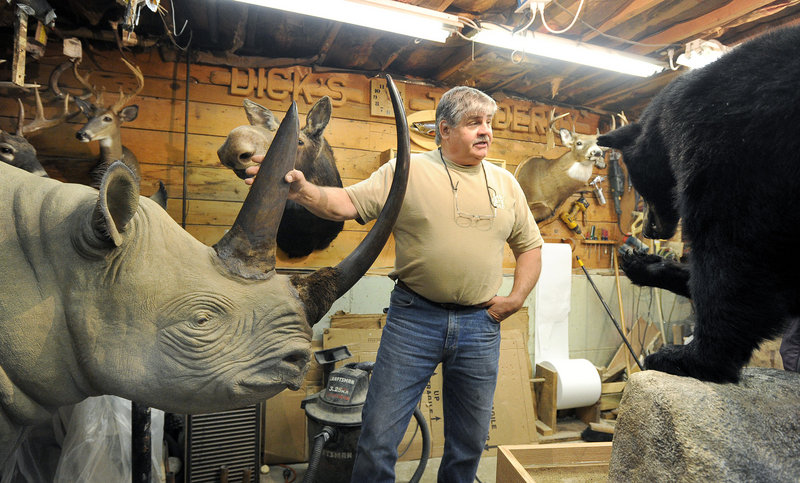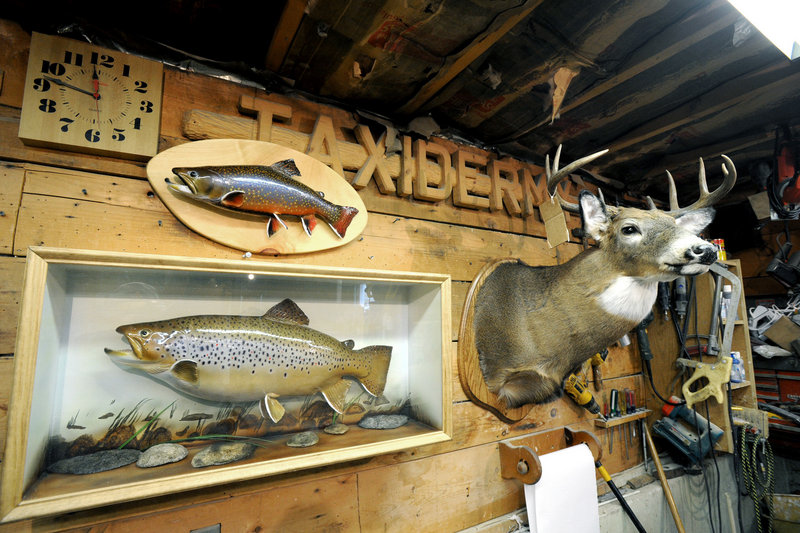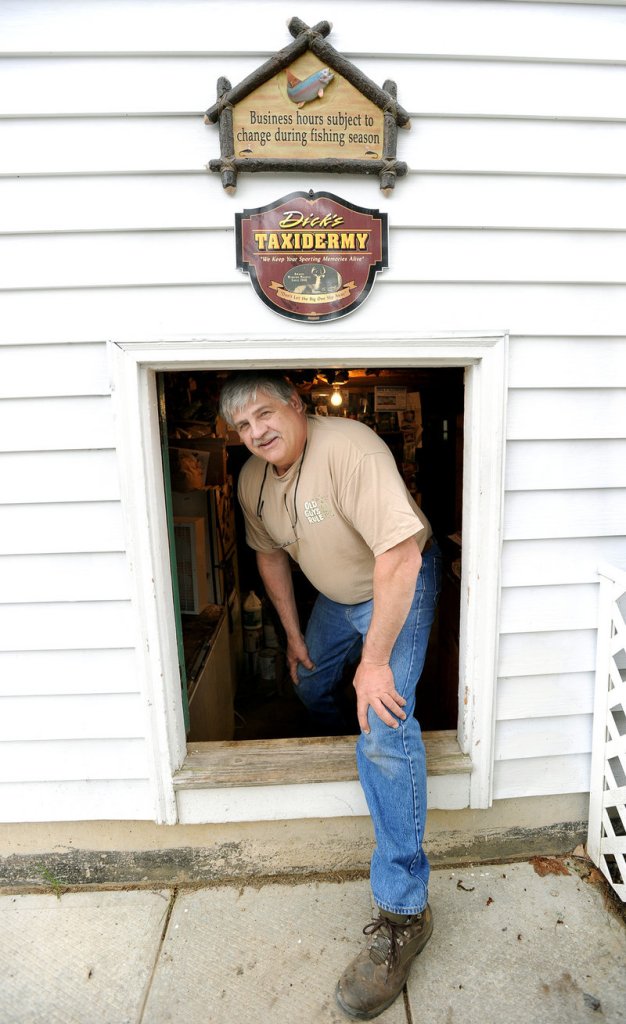LISBON FALLS – Dick Galgovitch turned a bad economy into a lifetime dream.
When Bath Iron Works downsized 16 years ago and his job was eliminated, he turned to the hobby he had pursued in his basement for 10 years and made a life around it.
Today Galgovitch is one of Maine’s busiest taxidermists, and the strange small door leading into a tiny basement room has housed a black rhinoceros, Alaskan brown bears and Giant Eland, as well as many moose, deer and bears.
“There will be a lot of turkeys coming in soon,” Galgovitch said earlier this month.
He’s taken a craft that dates back centuries in Maine and modernized it with use of auto putty and Styrofoam from boat docks.
Often he isn’t working with a hide or real scales. Sometimes it’s a photo and measurement.
In the case of the rhino, the only things left from the animal were the incredible horns.
He sculpted its tough hide, even its wrinkles. Sometimes he pins parts of the animals’ rough skin as it dries, then he paints it with life-like colors.
“It’s artistic, but it looks real,” Galgovitch said proudly.
In other instances he stretches the tanned skin, manipulates it and glues it.
“There are no air pockets if it’s right up against the skin mold. This is quite a process,” Galgovitch said.
The shop he works in is tiny, only big enough for a few mounts and a few people. He works there tirelessly.
He worked at Bath Iron Works as a supervisor for 22 years. He was a heavy-equipment operator, responsible for safety training
“I knew all those cranes inside and out,” Galgovitch said.
For 10 years during that time, he worked as a taxidermist and at the shipyard. Then his job was eliminated and he was given a severance package.
“I never looked back,” Galgovitch said.
And never stopped working. By May 5, he had worked every day this year.
He promises himself only two weeks off each year.
After a fishing trip in May he’ll work nearly every day until the third week of November, when it all shuts down for his annual deer trip to the Allagash, a trip he’s taken since 1974,.
“There are still small pockets of deer there, if you know where they are,” Galgovitch said. “We go for 10 days. We know the country. It’s backcountry camping, right in the wilderness.”
But then, Galgovitch is around fish and game every day, bringing them to life for other fishermen and hunters to admire.
He says modern-day mounts will endure far longer than the owner. Sometimes he uses ready-made models that are custom made for taxidermists. But when a customer asks for a certain view or stance, he molds the mounts from Styrofoam, an approach that makes them more real.
The cow moose head in his shop has its head low. It’s listening, curious.
The whitetail heads hold the traditional high-head pose. But elsewhere a brown trout is winning around rocks with a wag of its dorsal fin, fighting the hook stuck in its mouth.
With fish, he carves the body out of blue dock Styrofoam, the same material used for the diving platform at a lake house.
He makes a cast of the head with auto-body putty.
He pulls the skin over the mold he’s carved, waits for it to dry, then paints it, sometimes the brilliant reds and purples of the spawning season.
“Lots of taxidermists buy fish heads and fish bodies. I use all original parts. I trace out the fish body and carve it myself. It takes probably six weeks,” Galgovitch said. “When a fish skin is tanned, the color of the fish, the pigment of the scales loses color.”
He aspires for lifelike and long-lasting mounts.
“It’s my life. It’s quite a process,” he said.
Staff Writer Deirdre Fleming can be contacted at 791-6452 or at:
dfleming@pressherald.com
Twitter: FlemingPph
Send questions/comments to the editors.






Success. Please wait for the page to reload. If the page does not reload within 5 seconds, please refresh the page.
Enter your email and password to access comments.
Hi, to comment on stories you must . This profile is in addition to your subscription and website login.
Already have a commenting profile? .
Invalid username/password.
Please check your email to confirm and complete your registration.
Only subscribers are eligible to post comments. Please subscribe or login first for digital access. Here’s why.
Use the form below to reset your password. When you've submitted your account email, we will send an email with a reset code.